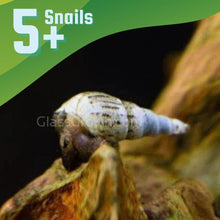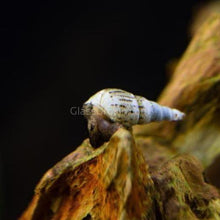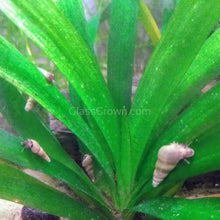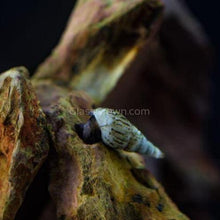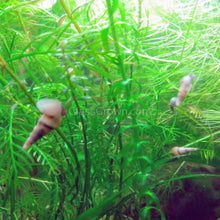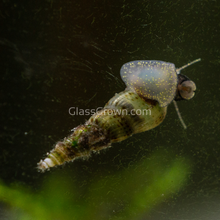
- Assorted mix of sizes and tones
- Essential to a natural, landscaped aquarium
- Algae-eating, and important substrate-sifters!
- Peaceful community snails, Growth to 1"
5+ would be a great for a bowl or jar under one gallon, but to really make an impact, consider ten or twenty packs!
10+ Malaysian Trumpet Snails, 20+ Malaysian Trumpet Snails
Cassandra's Notes:
Beautiful little burrowers!
These little guys play such an important role in a balanced aquarium! They are nature's recyclers, and work tirelessly to scrub detritus, algae and fish poo from your tank.
They are wonderful burrowers as well, and prefer a fine substrate such as sand. I love these in my sand tanks as they are perfect for sifting through the sand to remove all the gunk. Keeps the sand pristine, and also eliminates gas buildup in dense substrates!
If you don't see these snails too often, fear not! They love to dig and hide themselves. look for them whenever food is around, and in the morning and evenings. A trick I use is a single piece of blanched zucchini. They really come running! (be sure to remove the zucchini in a few hours, you don't need it fouling up your water.)
Peaceful and easy- going, Malaysian Trumpets do not eat live plants, but you may see them resting on green foliage in order to scrub away any algae or biofilms on the surface.
Malaysian Trumpets (sometimes called Red- Rimmed Melania) are undemanding, but would prefer a planted, community tank within normal parameters. They do like a bit of cuttlebone here and there to keep their shells hard and clear. Grab some of that here: Cuttlebone by Weight. Mine are grown in tanks of Ph 7-8, KH 2-8, GH 7-15, and a temperature of 65 to 85.
Under 40F where you are? Don’t forget your HEAT PACK!
Oddly for snails, Malaysian Trumpets (Melanoides tuberculata) are actually live- bearers! They'll produce a tiny miniature version of the adult snail. Trumpets can actually reproduce both sexually, and through parthenogenesis. They can clone themselves!
Do note that these types of snails may reproduce quickly in aquariums that get overfed. I typically use them as a sort of bellwether of the feeding levels in my aquariums. If I suddenly see a bump in baby snail numbers, I know that tank has a lot of extra food lying around. All tanks will eventually reach some kind of equilibrium of breeding and available food. In the meanwhile, hey... it's just more cleanup crew!






